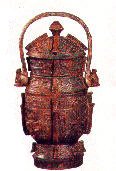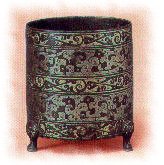Design Arts -- Bronzes
Tradition
There was a symbolic design used in Chinese sacrificial bronzes 3,000 years ago that combined all sorts of animal characteristics found in the natural world into one ferocious creature called the "beast of gluttony". Set in a fiercely blazing fire, the beast's bulging eyes glared straight at the observer with his mouth gaping in a wide grin and flashing saber-like teeth. His stiletto claws were exposed and poised for action, and a pair of ears or horns protruded from his head. As ferocious a sight as it is, it conveyed mystery and beauty. The "beast of gluttony" design is one of the most fantastic and imaginative to be found among Chinese bronze designs. It uniquely communicates the religious and ritual spirit of ancient Chinese bronze vessels.
Bronze is an alloy of copper, tin, and a small amount of lead. Its appearance signaled the advancement in human civilization from the Stone Age to the Bronze Age. For the approximately 2,000 years between the 17th century B.C. up until the Han Dynasty (206 B.C.-200 A.D.), the Chinese people used rare and precious bronze to cast large quantities of ritual vessels, musical instruments, and weapons that were elegant in form, finely decorated, and clearly inscribed with Chinese characters. These articles attest to the artistic achievement of ancient China and demonstrate how early Chinese used their ingenuity to create works incorporating both science and art from resources in nature.
In the ritualistic society of ancient China, bronze was used primarily for casting ceremonial temple vessels used in sacrifices to the gods of heaven, earth, the mountains, and the rivers. It was used to create vessels for banquets, honor awards, and funerals of the nobility. Because bronze was and still is such a durable material resistant to cracking and breaking, it was used by emperors to cast inscribed memorial vessels honoring the ancestors of dukes, princes, and ministers who had made a great contribution to their nation.

the Shang Dynasty |
In most of the designs used on bronzes, a main motif combined with a border design to emphasize its three-dimensional character. The "beast of gluttony" design had a side view of two separate symmetrical beasts embossed on a vessel; when viewed together from the front, they combined their features into one beast. After the Western Chou period (11th century B.C. to 771 B.C.), bird designs gradually replaced the "beast of gluttony" as the main designs while still maintaining the principle of symmetry. After the mid and late Western Chou period, chain link patterns, fish scale patterns, and wave patterns superseded animals as the main design of bronze vessels. At this point, the principle of symmetry began to be broken and substituted by repeating chain link designs that encircled the vessel. After the mid-Spring and Autumn period (770-476 B.C.), the most frequently used design was a vertically interlocking geometrical animal band design. Since the middle of the Western Chou period, border design became increasingly spare and obsolete. However, after the Spring and Autumn period, the "sprouting grain" and other designs began appearing in borders.

Cloud-patterned Bronze Article |
Over long periods of time, bronze articles exposed to high humidity or buried underground undergo a natural change in which they develop a bright and beautiful coating or patina. The patina serves to protect the metal underneath from further damage. However, the color of the patina, which may range from rouge red to emerald green to sapphire blue, adds beauty and elegance to the article. The Chinese are particularly fond of this colorful coating, and preserve it intact.
Modern Day
The beauty of traditional bronze art is still to be found in incense burners and sacrificial vessels in temples, in statues on display in schools, or in decorative pieces in homes. The application of traditional bronze designs has become an indispensable element of modern architecture, apparel, and furniture design. This is one way that the brilliance and artistry of the early Chinese continue their everlasting shine into the lives of Chinese today and of the future.



 Chinese Culture
Chinese Culture